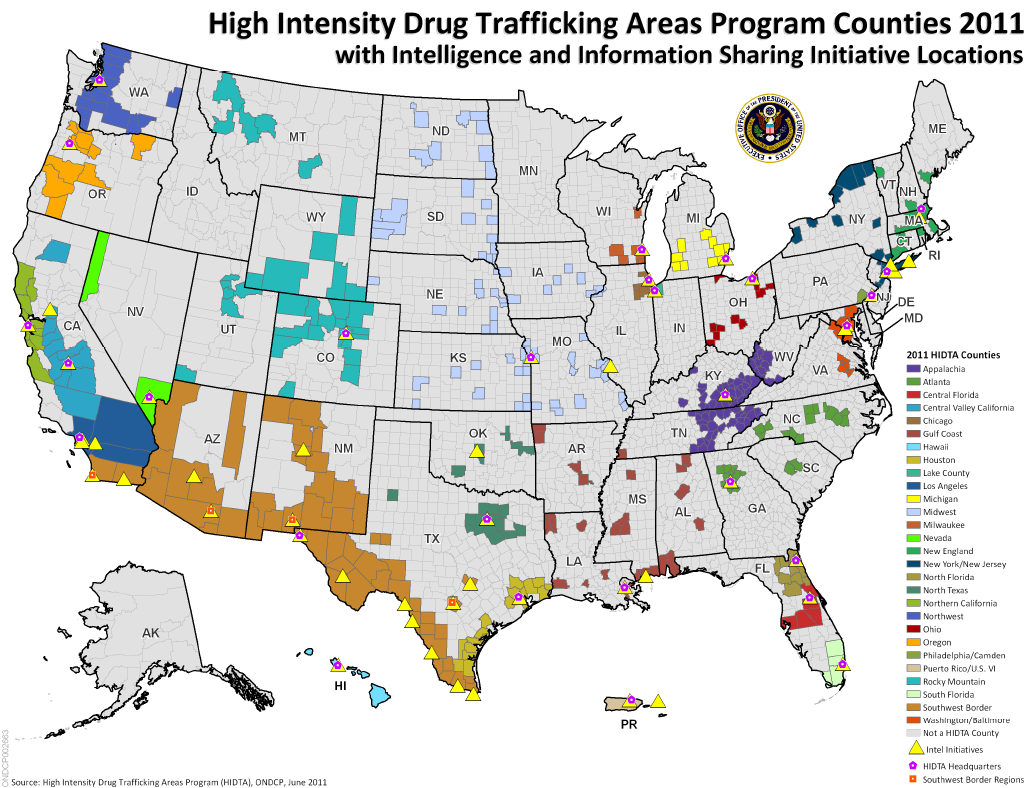High Intensity Drug Trafficking Areas (Hidta) Program
The High Intensity Drug Trafficking Areas (HIDTA) program, created by Congress with the Anti-Drug Abuse Act of 1988, provides assistance to Federal, State, local, and tribal law enforcement agencies operating in areas determined to be critical drug trafficking regions of the United States.
The purpose of the program is to reduce drug trafficking and production in the United States by:
- Facilitating cooperation among Federal, State, local, and tribal law enforcement agencies to share information and implement coordinated enforcement activities;
- Enhancing law enforcement intelligence sharing among Federal, State, local, and tribal law enforcement agencies;
- Providing reliable law enforcement intelligence to law enforcement agencies to facilitate the design of effective enforcement strategies and operations; and
- Supporting coordinated law enforcement strategies that make the most of available resources to reduce the supply of illegal drugs in designated areas of the United States and in the Nation as a whole.
Program Description
There are currently 28 HIDTAs, which include approximately 16 percent of all counties in the United States and 60 percent of the U.S. population. HIDTA-designated counties are located in 46 States, as well as in Puerto Rico, the U.S. Virgin Islands, and the District of Columbia.
At the local level, HIDTAs are directed and guided by Executive Boards comprising an equal number of regional Federal and non-Federal (State, local, and tribal) law enforcement leaders. A central feature of the HIDTA program is the discretion granted to the Executive Boards to design and implement initiatives that confront drug trafficking threats in each HIDTA. This flexibility ensures that each HIDTA Executive Board can tailor its strategy to local conditions and respond quickly to changes in those conditions.
Each HIDTA assesses the drug trafficking threat in its defined area for the upcoming year, develops a strategy to address that threat, designs initiatives to implement the strategy, proposes funding needed to carry out the initiatives, and prepares an annual report describing its performance the previous year. The program’s 57 operational intelligence and information sharing initiatives (see map on page 3) help HIDTAs identify new targets and trends, develop threat assessments, deconflict targets and events, and manage cases.
HIDTA Activities
The HIDTA program funds 670 initiatives throughout the country, including:
- Enforcement initiatives comprising multi-agency investigative, interdiction, and prosecution activities;
- Intelligence and information-sharing initiatives;
- Support for programs that provide assistance beyond the core enforcement and intelligence and information-sharing initiatives; and
- Drug use prevention and drug treatment initiatives.
A number of HIDTAs emphasize prevention and treatment as part of their anti-drug strategies.
For example:
- The Southwest Border (California Region) HIDTA works closely with more than a dozen other organizations on prevention initiatives, including drug courts, youth service organizations, and a U.S. Border Patrol program that educates children about drug use.
- In Washington State, the Northwest HIDTA promotes links with drug courts, community coalitions, public awareness campaigns, and other groups to support initiatives aimed at reducing substance abuse and preventing the initiation of drug use.
The HIDTA program also funds three initiatives that provide support to HIDTAs throughout the Nation by addressing specific drug trafficking concerns:
- The Domestic Marijuana Eradication and Investigation Project
- The National Methamphetamine and Pharmaceuticals Initiative
- The Domestic Highway Enforcement Program
In addition to these initiatives, the HIDTA program has awarded funds for Native American projects in the States of Arizona, New Mexico, Oregon, Texas, Oklahoma, and Washington.
Web sites: http://www.whitehousedrugpolicy.gov/HIDTA/overview.html
http://www.hidta.org/Programs/programs.asp
http://www.nhac.org/

Download PDF
